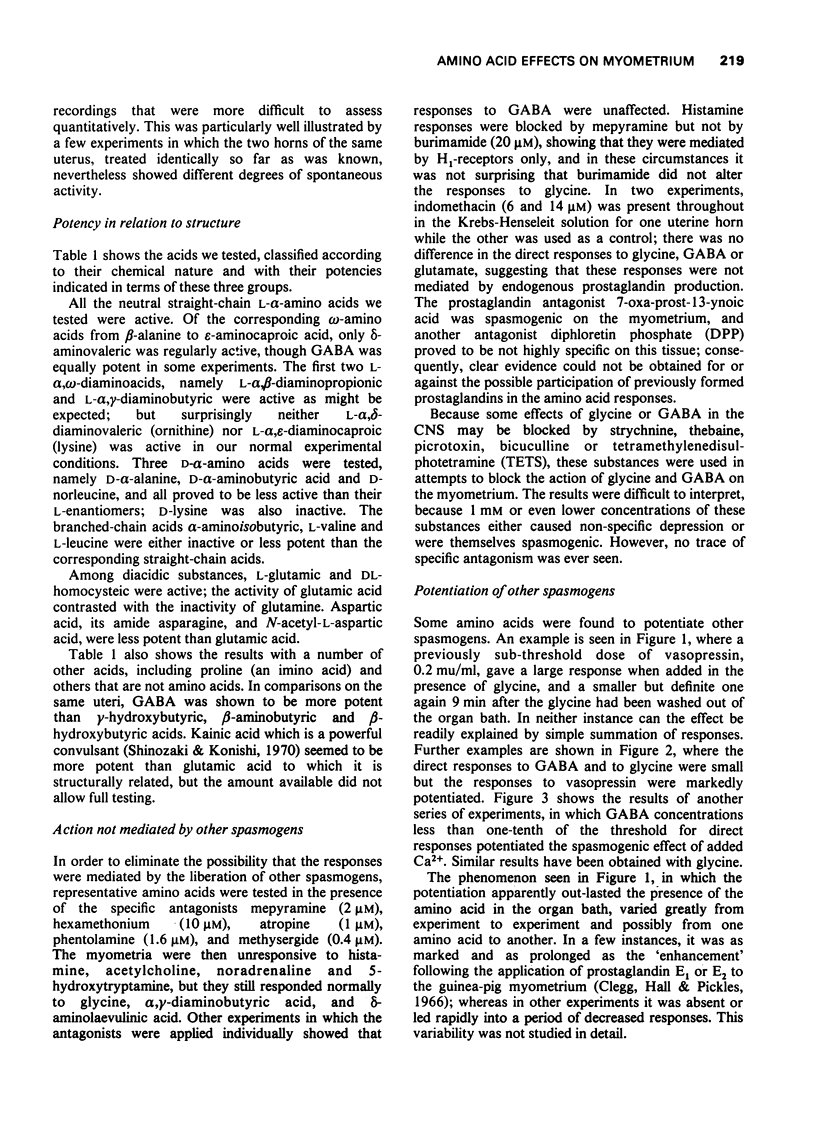Abstract
1 Thirty-three amino acids were applied separately in concentrations of 2 to 10 mM to guinea-pig uterine horns in vitro at pH 7.4. About half the acids regularly produced contractions.
2 Glycine and the straight-chain L-α-amino acids up to norleucine were active (longer ones not tested); D-isomers were less potent or inactive in these concentrations. The ω-amino acids γ-aminobutyric acid (GABA) and δ-aminovaleric, and the α,ω-diamino acids L-α,β-diaminopropionic and L-α,γ-diaminobutyric were active, whereas others of similar chain-length such as β-alanine and lysine were not. The diacidic acids, glutamic and homocysteic, were more active than the amido-amino acids, glutamine and asparagine. Histidine and phenylalanine showed little or no activity.
3 The use of appropriate blocking agents indicated that the responses to representative acids were not mediated by histamine, 5-hydroxytryptamine, acetylcholine, noradrenaline or by prostaglandins. Attempts to block the actions of glycine and GABA with strychnine, thebaine, picrotoxin, bicuculline or tetramethylenedisulphotetramine (TETS) were unsuccessful.
4 When some of the acids that were spasmogenic at 2 to 10 mM were applied at sub-spasmogenic doses, they transiently potentiated other spasmogens such as oxytocin or acetylcholine. This effect was also shown by a mixture of amino acids at approximately the normal plasma concentrations.
5 There is some similarity between the spasmogenic activities of different amino acids and their known abilities to depolarize neurones.
Full text
PDF





Selected References
These references are in PubMed. This may not be the complete list of references from this article.
- Clegg P. C., Hall W. J., Pickles V. R. The action of ketonic prostaglandins on the guinea-pig myometrium. J Physiol. 1966 Mar;183(1):123–144. doi: 10.1113/jphysiol.1966.sp007855. [DOI] [PMC free article] [PubMed] [Google Scholar]
- Evans R. H., Francis A. A., Watkins J. C. Bimodal action of glycine on frog spinal motoneurones. Brain Res. 1976 Dec 24;118(3):395–401. doi: 10.1016/0006-8993(76)90307-3. [DOI] [PubMed] [Google Scholar]
- Ishizawa M., Pickles V. R. Proceedings: A ocmparison of some smooth-muscle effects of GABA and of prostaglandin E1. Br J Pharmacol. 1975 Jun;54(2):279P–280P. [PMC free article] [PubMed] [Google Scholar]
- JONES H. C. The action of L-glutamic acid and of structurally related compounds on the hind gut of the crayfish. J Physiol. 1962 Nov;164:295–300. doi: 10.1113/jphysiol.1962.sp007022. [DOI] [PMC free article] [PubMed] [Google Scholar]
- Klingenberg H. G. Erregung des glatten Muskels durch Fluorid und Glutaminsäure. Z Biol. 1966 Feb;115(3):215–228. [PubMed] [Google Scholar]
- Lewis G. P., McMartin C., Rosenthal S. R., Yates C. Isolation and identification of pharmacologically active amino acids in skin and their structure-activity relationship on the guinea-pig ileum. Br J Pharmacol. 1972 May;45(1):104–117. doi: 10.1111/j.1476-5381.1972.tb09581.x. [DOI] [PMC free article] [PubMed] [Google Scholar]
- Nicoll R. A., Padjen A., Barker J. L. Analysis of amino acid responses on frog motoneurones. Neuropharmacology. 1976 Jan;15(1):45–53. doi: 10.1016/0028-3908(76)90096-4. [DOI] [PubMed] [Google Scholar]
- Sadasivudu B., Lajtha A. Metabolism of amino acids in incubated slices of mouse brain. J Neurochem. 1970 Aug;17(8):1299–1311. doi: 10.1111/j.1471-4159.1970.tb03379.x. [DOI] [PubMed] [Google Scholar]
- Shinozaki H., Konishi S. Actions of several anthelmintics and insecticides on rat cortical neurones. Brain Res. 1970 Dec 1;24(2):368–371. doi: 10.1016/0006-8993(70)90122-8. [DOI] [PubMed] [Google Scholar]


